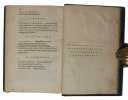4 books for « suetonius sueton ca... »Edit
XII Caesares: ex uetusto exemplari emendatiores multis locis. - [“ONE OF THE PRINCIPAL RENAISSANCE EDITIONS OF SUETONIUS’ LIVES OF THE TWELVE CAESARS”]
Paris, Ex officina Roberti Stephani, 1543. 8vo. In later half calf with gilt lettering to spine. Previous owner's name to front free end-paper (Poul Rubow, Danish screenplay writer). Wormtract in lower outer corner, far from affecting text. Underlined and annotated in margin in contemporary hand throughout. (16), 352, (2) pp.
One of the most important Renaissance editions of Sueton’s Twelve Caesars. """"In this edition, "" says Ernesti, ""Stephen first made use of the famous Memmian MS. which may be said to form the basis of the present general text of Suetonius."""" (Dibdin II.440). In terms of the history of typography it also claims an important role since the types of Claude Garamond, here used in the italic, were to become dominant in France and to assume an important place in the typeface of the Western world. ""Another early example of an edition of a Latin classic in Robert Estiennes new italic type. This has long been recognized to be one of the principal Renaissance editions of Suetonius' Lives of the Twelve Caesars, it was edited by Robert himself, who claims to have established the text with the help of a vetustum exemplar, which is believed to be the Codex Memmianus, our oldest and best MS of Suetonius"". (Schreiber No. 71) The Twelve Caesars, is a set of twelve biographies of Julius Caesar and the first 11 emperors of the Roman Empire written by Gaius Suetonius Tranquillus. The group is: Julius Caesar (d. 44 BC), Augustus, Tiberius, Caligula, Claudius, Nero, Galba, Otho, Vitellius, Vespasian, Titus, Domitian (d. 96 AD).The work, written in AD 121 during the reign of the emperor Hadrian, was the most popular work of Suetonius, at that time Hadrian's personal secretary, and is the largest among his surviving writings. The Twelve Caesars was considered very significant in antiquity and remains a primary source on Roman history.Renouard, p. 58, No. 11.Schreiber, Estienne No. 71
C. Suetonius Tranqvillvs, Ex Recensione Joannis Georgii Graevii cum ejusdem Animadversionibus, ut et Commentario integro, Laevinii Torrentii, Isaaci Causaboni, & Theodori Marcilii, nec non Selectis Aliorum. Editio secunda auctior & emandatior.
Hagae-Comitis (Haag), Johannem à Velsen & Trajecti ad Rhenum (Utrecht), 1691. 4to. Contemp. full calf. Raised bands. Spine ends worn, titlelabel nearly gone..A nick in leather at lower compartment. Spine and covers somewhat worn. Engraved frontispiece. (14),822,110 pp. + Index. 12 engraved plates of portraits, 1 folded table and many textillustrations (coins). 2 old names removed from titlepage, no loss of letters. Internally clean.
The second edition of the estimated Graevius-edition, which was first printed in 1672.A reprint of the popular first edition appeared in 1697, but before that this enlarged edition of 1691 had appeared. In 1703 the third edition appeared, and in 1708 another edition appeared under a changed title.Dibdin II:441, Graesse: 6:522
C. Svetonivs Tranqvillvs, Et in eum Commentarius, Exhibente Joanne Schildio. Editio Quarta.
Lugduni Batavorum (leiden), Ex Officina Franciski Hackii, 1662. 8vo. Contemp. full vellum. Handwritten title to spine. Engraved titelepage. (32),845,(27) pp. + Indexes. and 12 full-page engraved portraits. The 3 first leaves with a brownspot to upper ttight corner (incl. titlepage). A few scattered brownspots.
Opera. Textu ad praestantissimas editiones recognito continuo commentario ill., clavem Suetoniam adiecit Detlev Car. Guil. Baumgarten-Crusius. Vol. I-II (of 3).
Leipzig, Fleicherum, 1816. 8vo. Bound in 2 later hcalf. Gilt spines. LII,564(2),421 pp. Somewhat brownspotted.
 Write to the booksellers
Write to the booksellers




